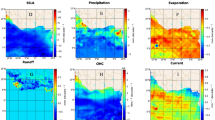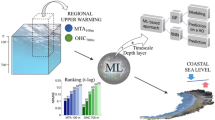Abstract
Geothermal heat flow, as a parameter characterizing the Earth's thermal state, records deep thermodynamic processes. However, measurements of heat flow (HF) in the oceanic crust are relatively sparse and susceptible to surface activity such as hydrothermal circulation. We propose a machine learning approach to predict marine HF (MHF). We apply the random forest (RF) regression algorithm to train predictors capable of mapping multiple geological and geophysical features to MHF, thus enabling HF prediction in the global oceanic crust. We generate three data sets with different qualities of HF measurements for training. The best predictor has an accuracy of ~ 0.13 (normalized root mean squared error) or ~ 0.07 (normalized mean absolute error), and the predicted global oceanic crust HF map reflects the basic pattern of the MHF distribution. We find by comparison that the quality of HF measurement affects the prediction results. Then, we use a cross-prediction scheme to screen out the "underestimated" measured HF cases, which are mostly located in tectonic environments such as mid-ocean ridges and back-arc basins and show high spatial correlation with hydrothermal circulation. Furthermore, we conduct experimental calculations for the extent and proportion of underestimated cases in the oceanic part of a new global heat flow (NGHF) database; for example, the proportion of records with the degree of underestimation greater than 50% is approximately 30.8%. These calculations can provide reference information for the selection and application of MHF records in the NGHF database.










Similar content being viewed by others
References
Afonso JC, Salajegheh F, Szwillus W, Ebbing J, Gaina C (2019) A global reference model of the lithosphere and upper mantle from joint inversion and analysis of multiple data sets. Geophys J Int 217(3):1602–1628
Alekseev D, Kuvshinov A, Palshin N (2015) Compilation of 3D global conductivity model of the Earth for space weather applications. Earth Planets Space 67(1):1–11
Amante C, Eakins BW (2008) ETOPO1 1 Arc-minute global relief model: procedures, data sources and analysis, national geophysical data center, NESDIS, NOAA, U.S. Department of Commerce, Boulder, CO, July 2008.
Beaulieu SE, Szafrański KM (2020) InterRidge global database of active submarine hydrothermal vent fields version 3.4. PANGAEA. https://doi.org/10.1594/PANGAEA.917894
Breiman L (2001) Random forests. Mach Learn 45(1):5–32
Coffin MF, Gahagan LM, Lawver LA (1997) Present-day Plate Boundary Digital Data Compilation. University of Texas Institute for Geophysics Technical Report No. 174, 5p. Updated in 2014
Commission for the Geological Map of the World, Bouysse P, Acharyya S, Bischoff D (2000) Geological map of the world. Commission for the geological map of the world, Paris
Davies JH (2013) Global map of solid Earth surface heat flow. Geochem Geophys Geosyst 14(10):4608–4622
Davies JH, Davies DR (2010) Earth’s surface heat flux. Solid Earth 1(1):5–24
Davis EE, Fisher AT (2011) Heat flow, seafloor: methods and observations. In: Gupta HK (ed) Encyclopedia of solid earth geophysics. Springer, Dordrecht. https://doi.org/10.1007/978-90-481-8702-7_65
Dong M, Zhang J, Xu X, Wu S-G (2019) The differences between the measured heat flow and BSR heat flow in the Shenhu gas hydrate drilling area, northern South China Sea. Energy Explor Exploit 37(2):756–769
Dong M, Zhang J, Brune S, Wu S, Fang G, Yu L (2020) Quantifying postrift lower crustal flow in the northern margin of the South China Sea. J Geophys Res Solid Earth 125(2):e2019JB018910
Gao X, Wang K (2014) Strength of stick-slip and creeping subduction megathrusts from heat flow observations. Science 345(6200):1038–1041
Goutorbe B, Poort J, Lucazeau F, Raillard S (2011) Global heat flow trends resolved from multiple geological and geophysical proxies. Geophys J Int 187(3):1405–1419
Harris RN, McNutt MK (2007) Heat flow on hot spot swells: evidence for fluid flow. J Geophys Res Solid Earth. https://doi.org/10.1029/2006JB004299
Hasterok D (2013) A heat flow based cooling model for tectonic plates. Earth Planet Sci Lett 361:34–43
Hosseini K, Matthews KJ, Sigloch K, Shephard GE, Domeier M, Tsekhmistrenko M (2018) SubMachine: web-based tools for exploring seismic tomography and other models of Earth’s deep interior. Geochem Geophys Geosyst 19(5):1464–1483
Ince ES, Barthelmes F, Reißland S, Elger K, Förste C, Flechtner F, Schuh H (2019) ICGEM–15 years of successful collection and distribution of global gravitational models, associated services, and future plans. Earth Syst Sci Data 11(2):647–674
Johnson P, Hutnak M (1997) Conductive heat loss in recent eruptions at mid-ocean ridges. Geophys Res Lett 24(23):3089–3092
Laske G, Masters G, Ma Z, Pasyanos M (2013) Update on CRUST1.0—A 1-degree Global Model of Earth's Crust. EGU2013–2658
Li C-F, Lu Y, Wang J (2017) A global reference model of Curie-point depths based on EMAG2. Sci Rep 7(1):45129. https://doi.org/10.1038/srep45129
Lister C (1972) On the thermal balance of a mid-ocean ridge. Geophys J Int 26(5):515–535
Lösing M, Ebbing J (2021) Predicting geothermal heat flow in Antarctica with a machine learning approach. J Geophys Res Solid Earth. https://doi.org/10.1029/2020JB021499
Lucazeau F (2019) Analysis and mapping of an updated terrestrial heat flow data set. Geochem Geophys Geosyst 20(8):4001–4024
Mareschal JC, Jaupart C, Phaneuf C, Perry C (2012) Geoneutrinos and the energy budget of the Earth. J Geodyn 54:43–54. https://doi.org/10.1016/j.jog.2011.10.005
Montelli R, Nolet G, Dahlen FA, Masters G (2006) A catalogue of deep mantle plumes: new results from finite-frequency tomography. Geochem Geophys Geosyst. https://doi.org/10.1029/2006GC001248
Müller RD, Sdrolias M, Gaina C, Roest WR (2008) Age, spreading rates, and spreading asymmetry of the world’s ocean crust. Geochem Geophys Geosyst. https://doi.org/10.1029/2007GC001743
Pedregosa F, Varoquaux G, Gramfort A, Michel V, Thirion B, Grisel O, Blondel M, Prettenhofer P, Weiss R, Dubourg V (2011) Scikit-learn: machine learning in Python. J Mach Learn Res 12:2825–2830
Phrampus BJ, Harris RN, Tréhu AM (2017) Heat flow bounds over the C ascadia margin derived from bottom simulating reflectors and implications for thermal models of subduction. Geochem Geophys Geosyst 18(9):3309–3326
Pollack HN, Hurter SJ, Johnson JR (1993) Heat flow from the Earth’s interior: analysis of the global data set. Rev Geophys 31(3):267–280
Reichstein M, Camps-Valls G, Stevens B, Jung M, Denzler J, Carvalhais N (2019) Deep learning and process understanding for data-driven Earth system science. Nature 566(7743):195–204
Rezvanbehbahani S, Stearns LA, Kadivar A, Walker JD, van der Veen CJ (2017) Predicting the geothermal heat flux in Greenland: a machine learning approach. Geophys Res Lett 44(24):12271–12279
Sclater JG, Hasterok D, Goutorbe B, Hillier J, Negrete R (2014) Marine heat flow. Springer, Dordrecht
Shapiro NM, Ritzwoller MH (2004) Inferring surface heat flux distributions guided by a global seismic model: particular application to Antarctica. Earth Planet Sci Lett 223(1–2):213–224
Stål T, Reading AM, Halpin JA, Whittaker JM (2020) Antarctic geothermal heat flow model: Aq1. Geochem Geophys Geosyst. https://doi.org/10.1029/2020GC009428
Szwillus W, Afonso JC, Ebbing J, Mooney WD (2019) Global crustal thickness and velocity structure from geostatistical analysis of seismic data. J Geophys Res Solid Earth 124(2):1626–1652
Turcotte DL, Schubert G (2014) Geodynamics, 3rd edn. Cambridge University Press, Cambridge
Zingerle P, Pail R, Gruber T, Oikonomidou X (2020) The combined global gravity field model XGM2019e. J Geodesy 94(7):1–12
Funding
The funded was provided by National natural science foundation of china (Grant Nos: 91858214 and 91858212).
Author information
Authors and Affiliations
Corresponding author
Additional information
Publisher's Note
Springer Nature remains neutral with regard to jurisdictional claims in published maps and institutional affiliations.
Supplementary Information
Below is the link to the electronic supplementary material.
Rights and permissions
About this article
Cite this article
Li, M., Huang, S., Dong, M. et al. Prediction of marine heat flow based on the random forest method and geological and geophysical features. Mar Geophys Res 42, 30 (2021). https://doi.org/10.1007/s11001-021-09452-y
Received:
Accepted:
Published:
DOI: https://doi.org/10.1007/s11001-021-09452-y




